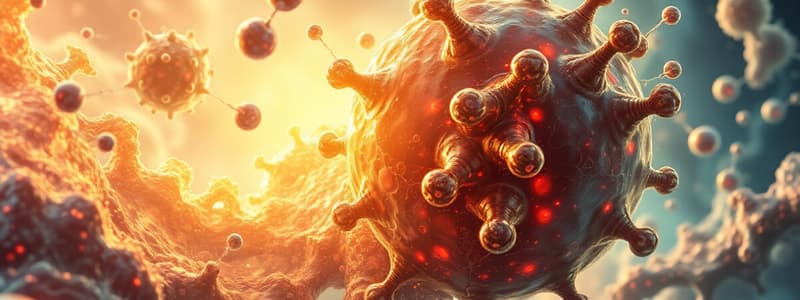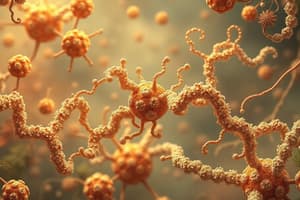Podcast
Questions and Answers
Which statement accurately describes the function of enzymes?
Which statement accurately describes the function of enzymes?
- Enzymes are consumed during the reaction process.
- Enzymes speed up reactions without being consumed. (correct)
- Enzymes increase the activation energy of a reaction.
- Enzymes are altered during the reaction process.
Enzymes are only used for industrial applications and not for medicinal purposes.
Enzymes are only used for industrial applications and not for medicinal purposes.
False (B)
What term is used to describe enzymes in a biological context, highlighting their catalytic nature?
What term is used to describe enzymes in a biological context, highlighting their catalytic nature?
biocatalysts
Enzymes accelerate reactions by reducing the _______ _______ of the reaction.
Enzymes accelerate reactions by reducing the _______ _______ of the reaction.
Match the following enzymes with their respective industries:
Match the following enzymes with their respective industries:
Which company supplies approximately 50% of the world's enzyme market?
Which company supplies approximately 50% of the world's enzyme market?
An enzyme's active site is only a small portion of its protein structure.
An enzyme's active site is only a small portion of its protein structure.
What term describes the molecules that enzymes act upon?
What term describes the molecules that enzymes act upon?
According to the 'induced fit' model, the shape of an enzyme _______ when a substrate binds.
According to the 'induced fit' model, the shape of an enzyme _______ when a substrate binds.
Match the enzyme name to the Industry / Application:
Match the enzyme name to the Industry / Application:
What is the result of a reaction that releases energy?
What is the result of a reaction that releases energy?
The activation energy of a reaction is increased by an enzyme.
The activation energy of a reaction is increased by an enzyme.
What name is given to the point at which the half the active sites are occupied?
What name is given to the point at which the half the active sites are occupied?
Enzymes are classified into six functional classes by the International Union of Biochemists (I.U.B.) based on the _______ of reactions they catalyze.
Enzymes are classified into six functional classes by the International Union of Biochemists (I.U.B.) based on the _______ of reactions they catalyze.
Match the enzyme class to the appropriate description:
Match the enzyme class to the appropriate description:
At what temperature do most enzymes work best?
At what temperature do most enzymes work best?
Enzymes always work best at a neutral pH of 7.
Enzymes always work best at a neutral pH of 7.
What name is given to the helper molecules which are required in addition to the protein for an enzyme to function?
What name is given to the helper molecules which are required in addition to the protein for an enzyme to function?
The enzyme _______, used to treat cystic fibrosis, works by breaking up mucus in the lungs.
The enzyme _______, used to treat cystic fibrosis, works by breaking up mucus in the lungs.
Match the enzyme with its function:
Match the enzyme with its function:
Flashcards
Enzymes (Biocatalysts)
Enzymes (Biocatalysts)
Biological catalysts that speed up the rate of chemical reactions without being altered or consumed.
Active Site
Active Site
The specific region of an enzyme where the substrate binds and the chemical reaction occurs.
Substrate
Substrate
The molecule upon which an enzyme acts.
Induced Fit
Induced Fit
Signup and view all the flashcards
Activation Energy
Activation Energy
Signup and view all the flashcards
Exergonic Reactions
Exergonic Reactions
Signup and view all the flashcards
Endergonic Reactions
Endergonic Reactions
Signup and view all the flashcards
Activation Energy
Activation Energy
Signup and view all the flashcards
Viscosity
Viscosity
Signup and view all the flashcards
Cofactors or Coenzymes
Cofactors or Coenzymes
Signup and view all the flashcards
Saturation Point
Saturation Point
Signup and view all the flashcards
Classification Number
Classification Number
Signup and view all the flashcards
Study Notes
Enzymes
- Biological catalysts (biocatalysts) are catalytic proteins.
- Thousands of chemical reactions are sped up by enzymes to make a cell/organism work.
- Enzymes lower the activation energy of a reaction.
- During the process, enzymes are neither altered nor consumed.
- Each enzyme molecule can catalyze a reaction many times, even into the billions.
Applications
- Enzymes are used in industries, analytical settings, and in medicine.
- Industrial applications include detergent enzymes like proteases and lipases.
- Enzymes are used in dairy like rennin for cheese production.
- Xylanase is used as a pulp and paper enzyme, while cellulase and ligninase are used in biofuels.
- Analytical applications accurately measure substance levels, like glucose oxidase measuring glucose in diabetics' blood.
- Medicinal applications include enzymes like DNAses, which break up DNA for cystic fibrosis patients, and tissue plasminogen activator (tPA) for heart attack.
Companies and Commercial Enzymes
- Novozyme supplies 50% of the world's enzyme market.
- Novozyme produces over 100 enzymes for several industries including dairy (animal feeds), brewing, and paper.
- Genencor (DuPont) is the second largest.
- Genencor's industrial enzymes are for food & beverages, animal feeds, water treatments, textiles, biofuels, and biodefense applications.
- Several Enzyme companies exist in Ireland.
- Megazyme produces diagnostic test kits.
- Sanofi-Genzyme provides treatments for diseases such as Cerezyme.
- Trinity Biotech produces diagnostic test kits.
Enzyme Terminology
- Enzymes act on specific molecules called substrates.
- Enzymes are sometimes called a ligand.
- Enzymes are proteins, but the active site is the only small part involved in actual reactions.
- Substrates bind in the active site where reactions take place.
- Substrates become products, but enzymes remain unchanged.
Enzyme Activity
- Substrates fit to the active site through a model of lock–key mechanism or the induced fit shape changes when substrate binds.
- Hexokinase helps breaks down glucose
- The reactioninvolves addition of phosphate group to Glucose + ATP -> Glucose-6 phosphate + ADP
- Glucose binding induces a change in shape of molecule and the addition of phosphate group
- In induced fit, charged amino acid residues can pull and stretch the bonds within a substrate.
- The binding of substrates alters the chemical environment within the catalytic site and slightly alters the site conformation.
Energy and Chemical Reactions
- Substrates (reactants) and products in a chemical reaction possess a particular energy amount.
- The difference between them can be expressed the Gibbs free energy (ΔG).
- When a reaction releases energy it has a negative (ΔG) value, and is said to be exergonic and spontaneous.
- A reaction that requires energy input is endergonic and has a positive (ΔG) value.
- The activation energy (Ea) refers to energy required to start a chemical reaction.
- The lower an (Ea) is in a reaction, the faster that reaction will occur.
- Enzymes lower (Ea) in a given reaction, speeding it up x10^5-10^11.
- Enzymes stabilize the transition state, thus lowering its energy.
Factors Affecting Enzyme Activity
- Most enzymes function best at 37°C and are inactivated at higher temperatures.
- Some enzymes are thermostable, so they work at extremely high temperatures > 95°C.
- Enzymes will denature at certain temperatures.
- Most enzymes function best at a pH of 7, with quite narrow ranges.
- Some enzymes work at lower and higher pH ranges.
- Pepsin in the stomach functions best at pH 2.
- Biotechnology can be used to create better enzymes.
Substrate Concentration
- A reaction reaches a saturation point when all enzyme molecules are occupied.
- Varying the concentration of the enzyme alters the Vmax.
- The point at which half the active sites are occupied represents the Michaelis constant (Km).
- At the Michaelis constant the velocity is V1/2
Coenzymes
- Most enzymes are proteins, but cofactors or coenzymes are additional molecules that help.
- During an enzyme catalyzed reaction, coenzymes may be modified, then regenerated for another reaction.
- Water soluble vitamins (B-complex e.g. niacin) are frequently used coenzymes in metabolism, making them key to diet.
- Metal ions like Zn and Cu are cofactors used frequently that may be firmly or loosely bound in active sites.
Naming Enzymes
- Enzyme names often end in –ase.
- Sucrose (invertase) catalyzes sucrose hydrolysis.
- The name often describes its function
- Oxidases catalyze oxidation reactions.
- Some enzymes, like digestion enzymes, have common names, such as rennin, pepsin and trypsin.
- Some names describe the substrate and function
- Alcohol dehydrogenase oxidizes ethanol.
- There are six functional classes of enzymes
- EC 1. Oxidoreductases
- EC 2. Transferases
- EC 3. Hydrolases
- EC 4. Lyases
- EC 5. Isomerases
- EC 6. Ligases
- Enzymes are classified by the International Union of Biochemists (I.U.B.) as EC numbers
- Each enzyme has an EC number, or classification number, made up of 4 digits.
- Example: EC: (2.7.1.1) HEXOKINASE
Activase
- Activase (Alteplase) is an enzyme called tissue plasminogen activator (tPA).
- tPA breaks up blood clots (blockages).
- Blood vessel blockages result in heart attacks and strokes (no. 1 cause of death).
- Activase was the first product (1986) from mammalian cells (CHO) to be approved.
- The FDA approved Activase to treat heart attacks, strokes, and pulmonary embolism.
Pulmozyme
- Cystic fibrosis (CF) is a common genetic disease in Ireland.
- CF is caused by mutation in gene (CFTR protein) involved in Cl- transport.
- CF results in build up of mucus in lungs, leading to chronic chest infections and other problems.
- Pulmozyme (Roche) is a DNase, a group of enzymes that breaks up DNA.
- The treatment reduces inflammation and viscosity of mucus, thus decreasing infection.
Studying That Suits You
Use AI to generate personalized quizzes and flashcards to suit your learning preferences.




